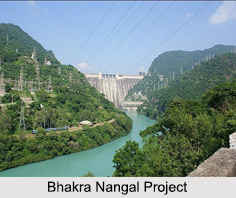 The Bhakra Nangal Project is a joint venture between the states of Punjab, Haryana and Rajasthan designed to harness the water from the Sutlej River for the benefit of the concerned states. It is a multipurpose river valley project in India that was started in 1948 and was completed in 1968.
The Bhakra Nangal Project is a joint venture between the states of Punjab, Haryana and Rajasthan designed to harness the water from the Sutlej River for the benefit of the concerned states. It is a multipurpose river valley project in India that was started in 1948 and was completed in 1968.
Purpose of Bhakra Nangal Project
Comprising of two dams at Bhakra and Nangal, the Bhakra Nangal Project is part of the Nangal Hydel Channel, the power houses with a combined installed capacity of 1,204 MW, electric transmission lines and the Bhakra canal system for irrigation. Together combined with all these, the project generates hydroelectricity, provides irrigation and solves the water crisis for the three north Indian states.
Bhakra Dam of Bhakra Nangal Project
Standing tall at a height of 226 m, the Bhakra Dam is one of the highest gravity dams in the world. Located in Bilaspur in the state of Himachal Pradesh, the dam has been constructed on the Sutlej River at the site of the Bhakra gorge near Rupnagar. The dam stretches for about 518 m with its maximum width at the base as 362 metres.
The Bhakra Dam has also created a huge reservoir of water which is 88 km long and 8 km wide and became the third largest reservoir of India with a high storage capacity of 987 crore cubic metres. This reservoir is named as Gobind Sagar Lake after Guru Gobind Singh, the 10th guru of the Sikh community.
Nangal Dam of Bhakra Nangal Project
Constructed at Nangal about 13 km downstream of the Bhakra Dam, the Nangal Dam stands tall at a height of 29 m and stretches for 305 m and is 121 m wide. Part of the Bhakra Nangal Project, the Nangal Dam is an auxiliary dam which serves as a balancing reservoir for taking up daily fluctuations from the Bhakra Dam.
Nangal Hydel Channel of Bhakra Nangal Project
One of the longest cemented canals of the world, the Nangal Hydel Channel is 64 km long, 42 m wide and 6 m deep canal that has been cemented throughout its length to avoid seepage. The main function of the hydel channel is to turn the turbines of power houses located below the Nangal Dam but it also supplies water to the Bhakra irrigation canals.
Power Houses of Bhakra Nangal Project
The power houses are one of the primary parts of the Bhakra Nangal Project and have been built to generate hydroelectricity from water of the Sutlej River. Located about 19 km and 29 km downstream of the Nangal Dam are the Ganguwal Power House and the Kotla Power House. Both of these power houses have two units of 24 MW each and one unit of 29 MW. The third power house is at Rupnagar.
On the Bhakra Dam, two more power houses were constructed, one on the left and the other on the right bank of the river. The installed capacity of these two power houses is 450 MW and 600 MW respectively.
Bhakra Canal System of Bhakra Nangal Project
Part of the Bhakra Nangal Project, the Bhakra Canal is 174 km long. The length of the canal system and that of the distributaries is 1,104 km and 3,360 km respectively. The Bhakra Canal system commands a gross area of about 27 lakh hectares and provides irrigation to about 15 lakh hectares. Out of this 38 percent is in Punjab, 47 percent in Haryana and the remaining 15 percent in Rajasthan.
Currently, the Bhakra Nangal Project like all other river valley projects suffers from the problem of silting. Water coming from the higher elevations deposits its silt at the bed of the reservoir, thereby reducing its capacity to store water.















